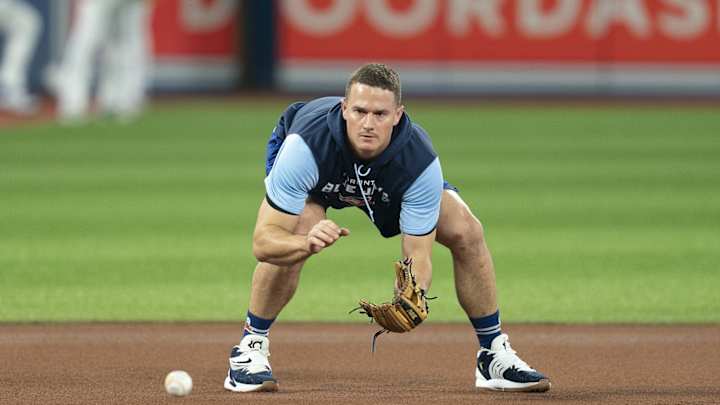How Matt Chapman Makes the Blue Jays Infield His Home

Before every home game, Matt Chapman bolts out of Toronto's clubhouse, up the dugout steps, and onto the infield dirt. He'll take a few warmup tosses with a teammate or coach before setting up shop a few steps off third base.
Chapman starts at normal depth on the infield, crouching down before scooping and firing to a coach at first or second base. As Blue Jays' infield coach Luis Rivera reaches for another ball, Chapman sets up again. Setup, scoop, fire. On repeat.
The warmup grounders are part of Chapman's daily routine, sharing fungos with Bo Bichette on the left side of Toronto’s infield. Chapman is a three-time Gold Glove winner and two-time best defender in baseball, but the daily labor doesn't stop. Coming to a new home field with new foul territory and a new infield, Chapman put in the work to make Toronto’s infield his new home, and it shows.
“Every day you learn the little ins and outs of your own field, learning some of the hops,” Chapman said. "I feel like I’ve gotten pretty used to it now, took me a little bit, but I definitely feel comfortable and confident here.”
Chapman has played 293 games at Oakland Coliseum, over 250 more than at any other park. He intimately knew the Oakland park's confines, the rangy foul territory, and the dead spots and weird bounces that would form after the now-Las Vegas Raiders would play on the infield the day before an A's game.
“When football seasons happened, I knew I needed to be on guard for some weird hops,“ Chapman said.
In Toronto, with turf and dirt infield (and no Argos anymore), the challenge is different. With the wind of Oakland and an open stadium, the A's infield would get dry and hard, Chapman said, while the Rogers Centre dirt plays “soft and true.”
At most stadiums, short grass plays quick and the ball doesn’t bounce as high. But on Toronto’s turf, infield coach Rivera said, the ball can bounce high at times and then lose the bounce when it hits the infield dirt—unless the dome is open. Toronto's grounds crew sprays down the infield with a layer of mist before every game, but when the roof is open the hot sun bakes the dirt, leading to higher bounces than usual.
The nuances take getting used to, and Chapman has already improved his defensive success rate 17% from April to May. The foreign short-hops at Rogers Centre are now predictable and he knows how high the second bounce on a chopper will be.
The familiarity comes from daily work with Toronto's third base and infield coach, Rivera. The long-time Expos and Red Sox shortstop joins Chapman on the infield hours before every game, hitting grounders and liners at random to the hot corner, mixing them up for a well-rounded practice. For the final few balls in the basket, Chapman can signal with his glove where he wants them hit, if there's anything specific he's working on. Right now, Toronto's third baseman is focused on investigating the different hops off the turf and dirt, asking Rivera to smack choppers downward for Chapman to play the bounces.
Matt Chapman, smooth operator. 😎#NextLevel | @BlueJays pic.twitter.com/Toe9DEf6rT
— Sportsnet (@Sportsnet) May 3, 2022
Another glaring difference between Toronto and Oakland is the foul ground. Even though Rogers Centre boasts the second-most foul territory in baseball, Oakland Coliseum has over 10,000 square feet more to work with. Getting accustomed to the new dimensions comes with time, Chapman said, but simply being around the park daily slowly teaches him how much room he has to work with.
“I can tell when I run out for foul balls, I’m like ‘Oh I don’t need to be chasing that one anymore,’" Chapman said. "I’m still learning my limits here.”
Toronto's foul ground should be a haven for Chapman, Rivera said. Though less foul territory probably costs him a few outs over the course of the season, now Chapman "doesn't have to run 50 yards to chase a fly ball."
"We care about the ones in between the lines,” Rivera said.
Chapman certainly has the plays between the lines covered. Even with a brief adjustment period to Toronto's infield, he hasn't committed an error at home yet this season, but there's somehow still room for growth. The 29-year-old currently ranks as an 81st percentile defender (per OAA) but was 98th percentile or better in his two previous full seasons.
A new home and new infield presented Chapman with a fresh defensive challenge this year. With time, comfortability, and more pre-game grounders, he'll soon re-take his place at the very top of defensive leaderboards.
